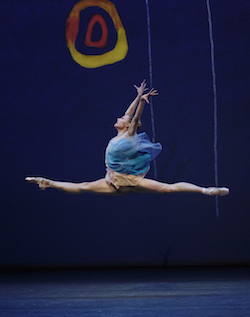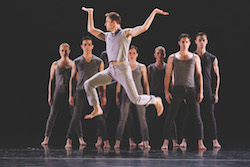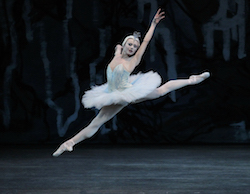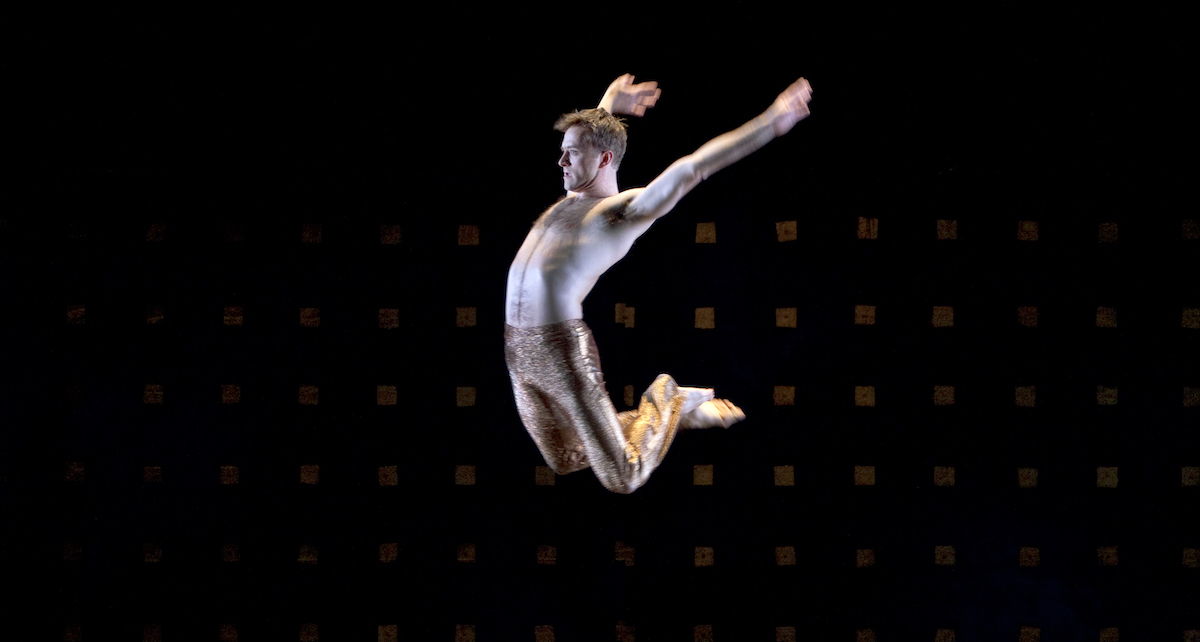Professional dancers give their all during a performance. Some do it eight shows a week, others don’t go on stage until 9pm, and many have to return to the studio the following day for another marathon of class, rehearsal and performance. So how do they do it? What are their secrets for taking care of their body, for recovering from an exhausting role and for having enough energy for the next day?
Here, Dance Informa speaks to two pros at the top of their game – New York City Ballet’s Sara Mearns and Paul Taylor Dance Company’s James Samson – for their post-performance care remedies.
How do you help yourself recover after long and physically demanding performances? What are your secrets to recovery?
Sara Mearns, principal dancer with New York City Ballet

NYCB’s Sara Mearns in Alexei Ratmansky’s ‘Pictures at an Exhibition’. Photo by Paul Kolnik.
“I immediately elevate my legs in my dressing room, even before taking off makeup and hair. Drink lots of water. Stretch your calves for about two to three minutes each. I don’t rush getting out of the theater; I let my body cool down. I eat a good amount of protein for dinner after the show and not a lot of empty carbs like bread or potatoes. Eat lots of veggies as well. I ice and heat calves and hamstrings while I’m eating my dinner. And always a glass of wine. I fall asleep around 1am and get up around 9:30am. I like my sleep, and my body needs that time to recover, so if I don’t have early rehearsal, I sleep more. I always take three Advil and magnesium before bed, and put Salon Pas on my calves for extra healing powers. I will also put Voltaren on certain muscles that are really in pain or strained.”
James Samson, dancer with the Paul Taylor Dance Company
“Lately, my muscles and body have become very exhausted after performances considering the accumulation of learning difficult repertory. As a result, it’s imperative that I do post-performance maintenance, which usually happens in my hotel room. I have two dense lacrosse balls that I lay on for about a half-hour, moving them around from my lower back and glutes down to the quadriceps. Then, a very hot bath afterward feels fantastic and relaxes the muscles even more. Lastly, I end the night with Ibuprofen.”
After an exhausting performance, what do you like to eat and drink?
Mearns
“Protein is the most important nutrient to have after a show. You have to rebuild your muscles. I also eat a lot of veggies to get my vitamins. I don’t take a multi-vitamin because I eat so healthily. I will have some pasta at dinner if I have an overly demanding day the next day. It will give me quick energy to start the day off. I eat all types of protein – meat, fish, eggs. I don’t believe in cutting things out of your diet. I have always been open to eating most things, and I haven’t had any issues thus far. I can’t eat as much cheese anymore, but that’s just because I like to savor it now.”
Samson
“After a performance, my diet is quite simple and typical. Protein and carbohydrates are imperative, yet I don’t overdo it because my appetite is not usually overwhelming. This diet helps muscle recovery and satisfies what the body desires after a night of expelled energy and calories. My sweet tooth kicks in as well, so I will indulge with a cookie or something tasty left over from hospitality at the theater. And, of course, lots of water is a good idea.”
How do you deal with lactic acid build-up and alleviate soreness the following day?
Samson

James Samson in Paul Taylor’s ‘Three Dubious Memories’. Photo by Paul B. Goode.
“Lactic acid can be a problem, but not so much for me right now. If there is a build-up or are feeling extra sore the next day, I will repeat my roll-out session from the night before. Rest is extremely important, so I may avoid partaking in activities and instead relax by the pool if given the opportunity.”
Mearns
“This is very hard for dancers because our highest, most intense workout of the day is from 8-11pm at night, and I, nine times out 10, have last ballet, so that means finishing close to 11pm. That doesn’t give much turnaround time for rehearsals starting at 11:30am the next day. The best you can do is elevate, lots of water, ice and heat, and take a warm Epsom [salt] bath when needed. I really hate taking baths, so I will avoid that at all costs, but it has to be done. Also, stretching after the show is crucial to your muscles not immediately stiffening due to such extreme activity. Also, rolling out on a back roller or trigger point roller keeps the blood flowing, and light massage is always good for post-activity.”
After an exhausting performance, how do you try to ensure you’ll have energy for the next day?
Mearns
“It’s about what you eat post-performance, and getting your sleep. Your body has to rest. For me, that’s nine hours of sleep. I am a 150 percent dancer and always have 12-hour days of exercising, so sleep is my best friend.”
Samson
“I make sure to do my post-performance exercises, drink lots of water, and get plenty of rest in order for my body and mind to recover.”
In your experience, what are some of the most demanding roles you’ve had? After an intense performance like that, does your schedule usually require you to come back to dance the following day?
Mearns

Sara Mearns in Peter Martins’ ‘Swan Lake’. Photo by Paul Kolnick.
“Swan Lake, Diamonds, Mozartiana, Faust, Kammermusik, Allegro, Pictures at an Exhibition, Brahms Schoenberg fourth movement, Concerto Barroco. This is just to name a few. And yes, there are weeks where I have 12 ballets, two ballets a night every show, and you rehearse all day, every day. During performance season, we only have Monday off. I have done 18 shows in a row before. I have done Swan Lake and then woken up to have the matinee the following day. No one dances more or harder then the dancers at NYCB.”
Samson
“Yes, sometimes after a grueling, exhausting performance, we have to do it again the next day, which at times may include an early kid’s performance or matinee. There are many demanding roles I have had, like Johnny in Company B or one of the four men in Cloven Kingdom. Doing roles like these day after day on tour is challenging, but nothing is more challenging than doing these roles in altitude. Even with having oxygen tanks backstage, I sometimes feel like collapsing or throwing up. How rewarding it is, however, to make it through and know that I did it.”
Any other post-performance care secrets?
Mearns
“Everyone is different. What works for your friend may not work for you. Listen to your body, and try different things out. And also, every night is different because what your body has gone through that day will not be the same as yesterday or tomorrow. Don’t get stuck in one regiment; your body is constantly changing.”
Samson
“Not for myself, but for others to know that everyone is different in having their own post-performance routine. You must be smart and know what works for your body. Also, keep on a routine because the older you become, the harder it gets. You have to take care of yourself if you want sustain a career in dance.”
By Laura Di Orio of Dance Informa.
Each body is different. Please speak to a health professional about your individual post-performance needs before applying any of the above to your post-performance routine. Only use medications, supplements, and creams that you know are safe for your body and only in the recommended amounts written on the label.
Photo (top): James Samson in Paul Taylor’s ‘Byzantium’. Photo by Paul B. Goode.















